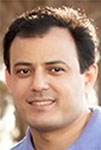Interlaminar modelling to predict composite coiled tube failure
Siamak Mishani A , Brian Evans A , Vamegh Rasouli A , Reem Roufail A , Soren Soe B and Peter Jaensch BA Department of Petroleum Engineering, Curtin University
B Deep Exploration Technologies Cooperative Research Centre
The APPEA Journal 55(1) 361-370 https://doi.org/10.1071/AJ14029
Published: 2015
Abstract
In a field operation that uses coiled tubing in its applications, fibre-reinforced polymer matrix composite tubing is seldom used. Fibre-composite coiled tubes offer advantages, compared to steel material, through a reduction in weight and improvement in fatigue life.
The stiffness of composite material degrades progressively when increasing the number of cyclic loading. The fatigue damage and failure criteria of fibre-reinforced composite coiled tubes are more complex than that of steel; hence, failure predictions are somewhat unreliable.
Among the defects in composite materials, interlaminar delamination is the foremost problem in fibre-reinforced composite material, and it leads to a reduction in strength and stiffness especially in cyclic-load conditions. Delamination causes a redistribution of the load path along the composite structure, which is unpredictable; therefore, delamination in a composite coiled tube in an oil and gas field eventually leads to final failure, which could be catastrophic.
A-ply-by-ply mathematical modelling and numerical simulation method was developed to predict interlaminar delamination of filament-wound composite coiled tubes under a combination of different loading scenarios with consideration to low-cycle fatigue.
The objective of this paper is to explain interlaminar delamination as an initial crack and source of stress concentration in composite coiled tubes in the framework of meso-cracking progression of matrix damage modelling of composite laminates.
The paper focuses on delamination failure because the largest span of the composite lifecycle is at the crack propagation phase, which manifests itself in the form of delamination. The analysis shows that the crack front tip is not uniform, and also shows that carbon fibre possesses higher stiffness values compared to glass fibre. The paper confirms that 2D modelling cannot express the real release strain energy rate at the crack front tip. Mode-I testing, however, showed that the double cantilever beam (DCB) only represents the normal stress from the release strain energy rate. The results also indicated that there were other sources contributing to the strain energy release rate, such as inter-layer frictions and normal stress in the end notched flexure (ENF) testing mode.

Siamak Mishani holds a Bachelor of Mechanical Engineering degree and a Master of Science degree in executive management of business administration. He is now undertaking his PhD research at Curtin University’s Department of Petroleum Engineering. Siamak has worked for more than 20 years in—and has in-depth knowledge of—the designing and engineering of coiled tubing and drilling operations. His research aims are to compare the complex stress analyses in composite and steel coiled tubes to improve their mechanical properties under cyclic loading. |

Brian Evans is a Professor in Curtin University’s Department of Petroleum Engineering. His background includes graduation as an electrical engineer, mud logger and operations geophysicist, and later as an academic. He helped establish the Department of Exploration Geophysics at Curtin University. Brian won the 2006 Society of Exploration Geophysicists (SEG) International Distinguished Achievement Award, the 2013 Society of Petroleum Engineers (SPE) International Faculty Award, and the 2014 Subsea Energy Australia (SEA) Business Special Recognition Award. He is the author of the SEG book A Handbook for Seismic Data Acquisition in Exploration. |

Vamegh Rasouli is a Professor in Curtin University’s Department of Petroleum Engineering. He is a Chartered Professional Engineer (CPEng) and is a registered engineer with the National Professional Engineers Register (NPER) of Australia. Vamegh received his PhD from Imperial College London in 2002. In 2006, after joining Curtin University, Vamegh established the Curtin Petroleum Geo-mechanics Group (CPGG), and the Curtin Drilling Research Group (CDRG) in 2010. Vamegh is supervising a number of PhD students and is involved in a number of research and consulting projects in the area of geo-mechanics and drilling. He has undertaken several projects related to petroleum geo-mechanics for various companies, and has also been a consulting engineer on various geo-mechanics-related projects with Schlumberger’s Data and Consulting Services (DCS) in Perth. |

Reem Roufail has a diverse technical background. She earned her BSc and MSc degrees in mechanical engineering from the American University in Cairo, specialising in materials engineering in her BSc degree and material selection for design and failure analysis in her MSc degree. She joined the mining industry through mineral processing consultants in Canada (G&T Metallurgical Services in Kamloops). Reem then undertook her PhD in mining engineering at the University of British Columbia (titled The Effect of Stirred Mill Operation on Particles Breakage Mechanism, and their Morphological Features). Reem is now working on DET CRC’s Project 1.1. Her focus is on selecting the most appropriate coiled tubing material for the coiled tubing drill rig. Her experimental research identifies the strength and bending fatigue resistance of potential coiled tubing materials. She also uses computer numerical analysis to study the distribution of stresses on the coiled tubing in bending. |

Soren Soe is DET CRC’s leader for Project 1.1: Next Generation Drilling Technologies. Soren has held various project, engineering and executive leadership positions since completing his Bachelor of Science degree in engineering in 1991. He has worked extensively with leading the development of onshore drilling rigs for mineral exploration, production holes, geotechnical applications and coiled tubing rigs for the oil and gas industry. During his career, Soren has expatriated to China, The Netherlands and Poland with such companies as Knebel Drilling A/S, Boart Longyear and A.P. Moller-Maersk. |

Peter Jaensch received his BEng degree in mechanical engineering from the University of South Australia in 1997. Since 1990 Peter has worked for a number of organisations—primarily in research and product development—in fields such as automotive components, special purpose machinery, printing industry new technologies, equine racing equipment, beef abattoir equipment, and mineral exploration drilling equipment. Peter started with Boart Longyear in June 2010 and he lead the engineering team in the development of the LX12 multipurpose drill rig. Peter has been with DET CRC’s Project 1.1 since September 2013 to develop the composite drill to a point where the torsional load and axial load capabilities are adequate for typical drilling operations. |


